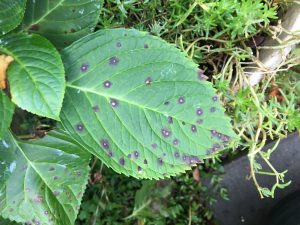Hydrangeas could be affected by fungus after wet weather
Published 4:30 pm Friday, July 14, 2017

The fungal leaf spots seen above on the hydrangea leaf can be linked to the frequent rains Decatur County has been getting over the past few weeks.
By: Ty Torrance
Frequent wet weather can cause various problems in the landscape. One plant in particular that I have noticed with a common problem is the hydrangea.
These plants can easily get a fungal leaf spot called cercospora leaf spot. This leaf spot can affect most hydrangeas and is generally an aesthetic issue for homeowners. The pathogen will rarely kill the plant but can reduce plant vigor by defoliation. It is generally more problematic in low maintenance landscape situations or when homeowners overhead irrigate their plants.
In our particular situation this year I believe the frequent rains can be to blame. Depending on the type of hydrangea (oakleaf, bigleaf, etc.), the leaf spot symptoms may vary in appearance. Spotting generally begins at the base of the plant on older leaves and works its’ way up the plant. The spots are generally small, circular, and scattered across the leaf surface. They tend to have tan centers and dark brown or purple borders (see images). The leaf spots can oftentimes be irregular or angular shaped.
The fungus survives in fallen diseased leaves that remain on the ground.
Therefore, sanitation to remove the dying and diseased leaves will help prevent subsequent infections or outbreaks. The conidia or spores of the fungus are spread by splashing water. This can be from rain, which is impossible to control, or from overhead irrigation. It is important to minimize the amount of leaf wetness. If at all possible, install soaker hoses or drip irrigation to prevent water-splash on the leaves.
If your lawn irrigation system just barely hits the hydrangeas, then, yes, this will be problematic and can create an environment that supports the reproduction and growth of this fungal pathogen. In severe cases, as previously mentioned, defoliation can occur, which reduces vigor and growth of the plant. Fungicide applications are rarely warranted. Protectant fungicides are available for homeowners who just have to spray something or for severe cases of this fungal leaf spot. They include (listed by active ingredient): Chlorothalonil, Myclobutanil, Mancozeb, and Thiophanate-methyl. Begin spraying when spotting is first seen and follow the label for repeat applications (usually every 10-14 days).
If you have any questions, please call the Decatur County Extension office at (229) 248-3033.




